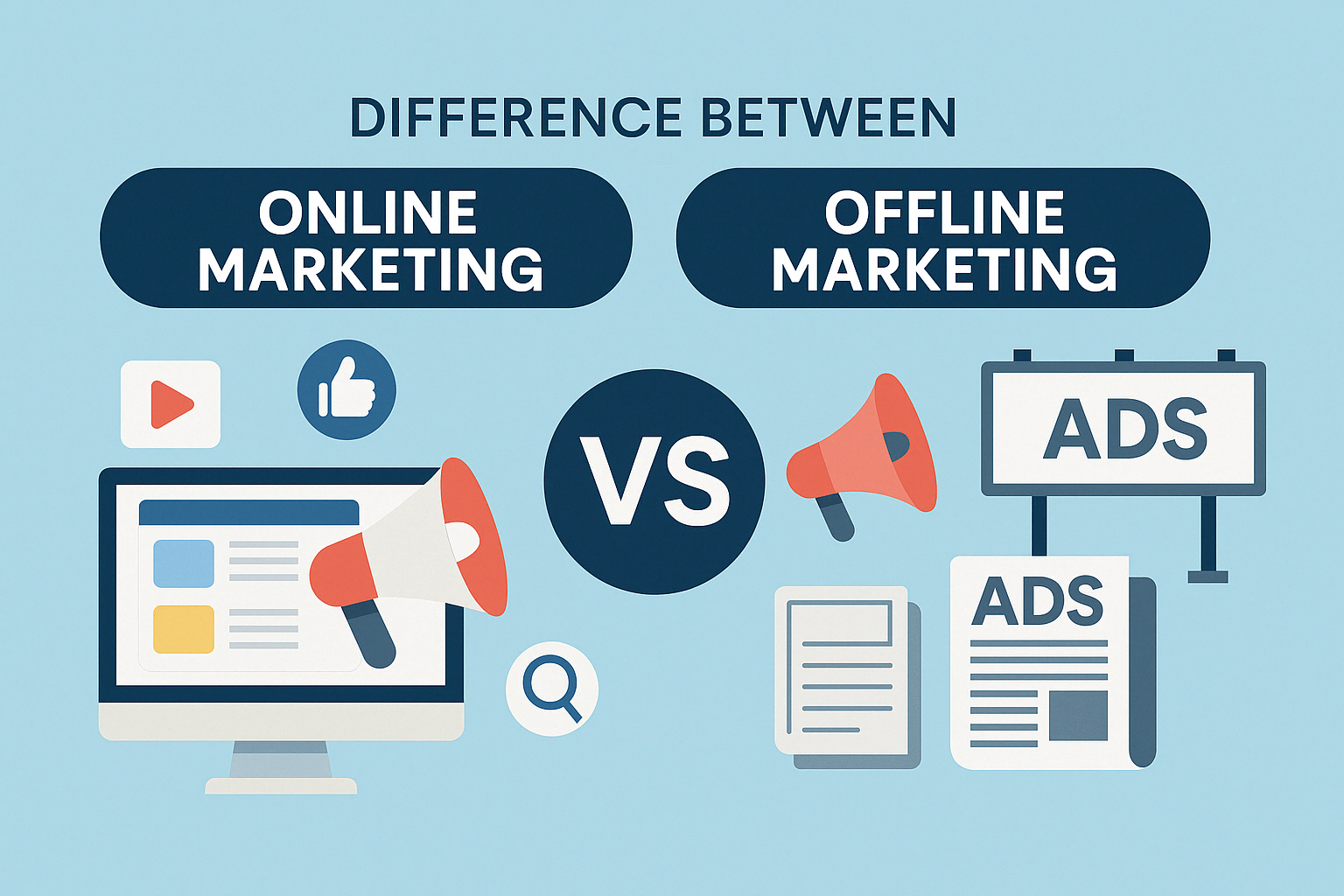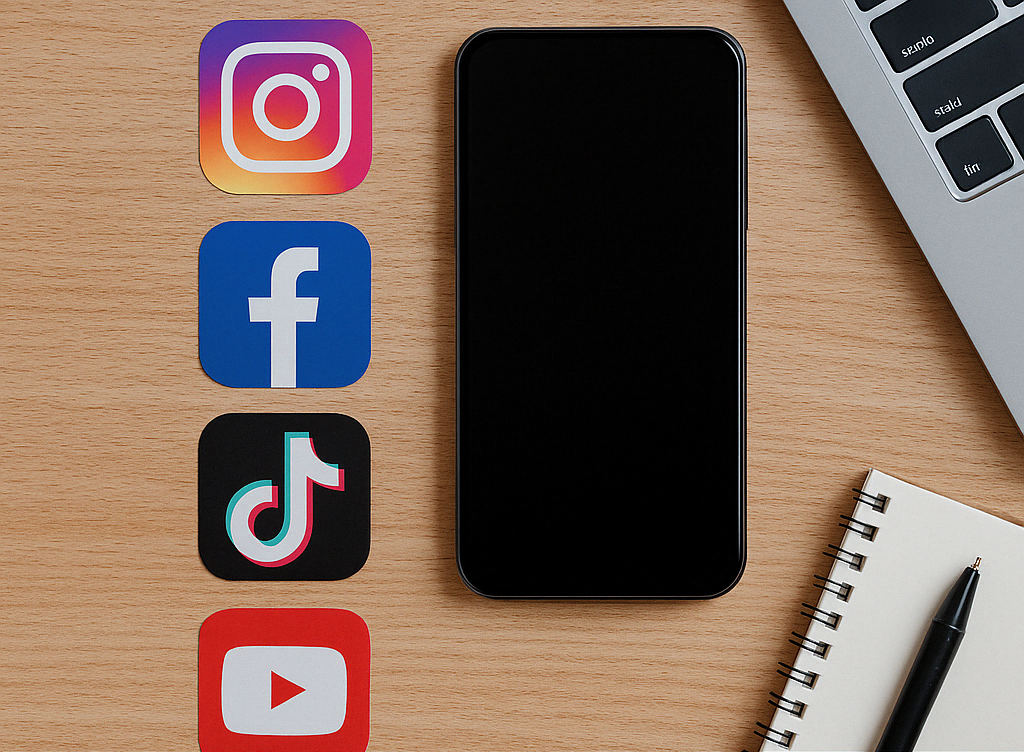Difference Between Online Marketing and Offline Marketing: Which One Wins?
In today’s fast-paced world, businesses are constantly evolving, and so are the ways they market their products and services. Traditional marketing techniques are still important, but online marketing has taken over as a dominant force in the business world. So, what’s the difference between online marketing and offline marketing?
In this blog, we’ll break down both types of marketing and explain why online marketing has become the more effective strategy for businesses of all sizes.
1. Online Marketing – Marketing in the Digital World
Online marketing, also known as digital marketing, refers to the use of the internet and other digital platforms to promote products or services. This includes a wide variety of strategies, such as:
- Social Media Marketing (Facebook, Instagram, Twitter)
- Email Marketing
- Search Engine Optimization (SEO)
- Pay-Per-Click Advertising (PPC)
- Content Marketing (blogs, videos, infographics)
Key Benefits of Online Marketing:
- Global Reach: With the internet, your marketing efforts can reach a worldwide audience 24/7.
- Cost-Effective: Online marketing is often more affordable than traditional methods.
- Real-Time Analytics: Marketers can track the performance of campaigns in real time and make immediate adjustments.
- Targeted Advertising: Online marketing allows you to target specific demographics based on data such as age, location, interests, and browsing behavior.
2. Offline Marketing – Traditional Marketing Methods
Offline marketing, also known as traditional marketing, includes methods such as print advertising, television, radio, direct mail, billboards, and events. These tactics have been used for decades to build brand awareness and drive sales.
Key Benefits of Offline Marketing:
- Personal Connection: Some consumers feel a stronger personal connection with offline ads, such as a local radio ad or a billboard in their neighborhood.
- Tangible Results: Physical marketing materials, like brochures or business cards, can leave a lasting impression.
- Broad Audience: Offline marketing can reach people who might not be active online, such as older generations or people in rural areas.
3. Key Differences Between Online and Offline Marketing
| Factor | Online Marketing | Offline Marketing |
|---|---|---|
| Audience Reach | Global and targeted through the internet | Local, regional, or national, often generalized |
| Cost | Generally lower, with more budget options | Can be expensive (TV, print, etc.) |
| Real-Time Analytics | Immediate feedback and insights | No instant way to measure success |
| Ad Targeting | Highly targeted based on demographics and behavior | Broad and untargeted audience |
| Reach Duration | Can reach audiences anytime and anywhere | Limited by location and time |
| Customer Interaction | Immediate interaction via social media, websites, etc. | Limited to physical or scheduled events |
4. Why Online Marketing is Better Than Offline Marketing
While both types of marketing have their merits, online marketing outshines offline marketing in several key areas. Here’s why:
1. Wider Reach and Targeting
Online marketing allows businesses to reach audiences globally with targeted campaigns. Through platforms like Google Ads or Facebook Ads, businesses can select precise demographics, interests, and behaviors to target. This level of precision is unmatched by offline marketing methods.
2. Lower Costs, Higher ROI
Online marketing campaigns often have a lower entry cost compared to TV or radio ads. For example, running a Google Ads campaign or posting on social media can be highly cost-effective, especially for small businesses. Additionally, with digital marketing, you can adjust your budget and optimize your ads to ensure a higher return on investment (ROI).
3. Real-Time Results and Adjustments
With online marketing, you get instant feedback on how your campaigns are performing. If something isn’t working, you can immediately optimize your ads or change your strategy. In contrast, offline marketing campaigns require longer lead times and provide delayed feedback, making adjustments difficult.
4. Flexible and Scalable
Online marketing is highly scalable. You can start with a small budget and gradually scale up as your business grows. On the other hand, offline marketing, such as print ads or billboards, requires significant upfront investment and doesn’t offer as much flexibility for testing or adjustments.
5. Better Customer Interaction and Engagement
Through platforms like Instagram, Twitter, and Facebook, businesses can engage directly with their customers in real time. This allows for better relationships, instant feedback, and customer loyalty. Offline marketing doesn’t provide this level of interactive engagement.
Final Thoughts: Why Online Marketing Wins
Both online and offline marketing have their places in a marketing strategy. However, in the modern business world, online marketing is by far the more effective, affordable, and scalable option for most businesses. With global reach, targeted advertising, real-time feedback, and higher ROI, online marketing empowers businesses to stay competitive in the ever-evolving digital landscape.
Start Your Online Marketing Journey Today!
Ready to take your business to the next level with online marketing? Reach out to us to develop a customized digital marketing strategy that helps you grow your business and maximize your online presence.


